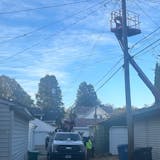Minnesota has surpassed 10,000 confirmed COVID-19 deaths, officials announced Wednesday, a grim reminder of the cost of the pandemic in 2021 even after vaccines became available.
The Minnesota Department of Health reported 54 more COVID-19 deaths confirmed by testing, raising the total to 10,018. Another 124 deaths since the start of the pandemic in March 2020 were likely because of COVID-19 but weren't confirmed by testing.
"There is a heaviness, for sure, hitting this sort of a marker and the fact that we have had so many deaths this year even after we have more tools available to protect against it," state Health Commissioner Jan Malcolm said. "Every death is a terrible loss. The more tools we have and the more preventable these things truly are, the more heartbreaking it is that we still are losing people."
Minnesota's losses in the past three months included the state's first four teenagers to die of COVID-19, as well as farmers, teachers, corrections officers and mechanics. In the past month, the state lost a former police chief, chemistry professor and an aerospace engineer.
On Wednesday, friends and relatives mourned at a memorial service for Jose Juan Lopez Quezada, the 43-year-old owner of the popular Rancho Grande restaurant in Buffalo who died of COVID-19 on Nov. 12. On Nov. 13, guitarist Robert Walker played a cover of "Knockin' on Heaven's Door" at the Old Muni in Cook in far northeastern Minnesota in memory of drummer and bandmate Peter Garman. The 55-year-old died of COVID-19 on Nov. 6.
"That's for our brother," Walker said as the last guitar chord faded.
A pandemic wave caused by the fast-spreading delta variant of the coronavirus this fall has quickened the toll in Minnesota. It took 188 days from March to September for Minnesota to go from 7,000 to 8,000 deaths, but then 58 days to reach 9,000 and 35 days to reach 10,000, according to state health data.
State health officials are hopeful that an uptick in vaccinations and booster doses has slowed the wave. Minnesota's coronavirus infection rate has declined since Dec. 6, according to the Centers for Disease Control and Prevention, and ranks seventh-worst among states after being the worst in the nation in November.


